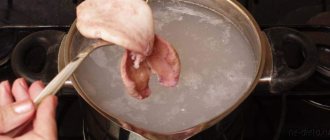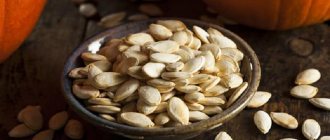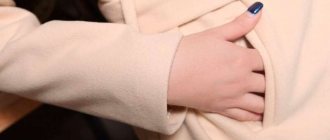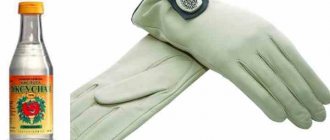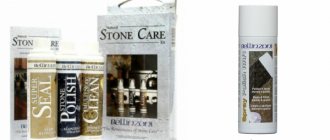What substances are used for starching?
Cotton products were always starched, as the procedure helped to give rigidity to the shape of the product. After starching, the fabric became snow-white and did not become dirty for a long time. For the procedure, we used starch, which is found in many plants: corn, potatoes, rice. But synthetic products can also be used for starching products.
Edible gelatin
Perfectly fixes the shape of the cap if it is made of colored fabrics with synthetic additives or gelatin. The substance is diluted in water in a proportion of 3 tablespoons per liter. Heat the solution slowly, stirring until the crystals dissolve completely. Caps, medical or chef's, are lowered into warm liquid. It is necessary that the fabric is completely saturated. Then take it out, removing excess liquid from the product with your hand. Give the headdress the desired shape and leave it to dry.
PVA glue
For white caps, PVA construction glue is useful. It will enhance the whiteness, but the stationery will make the cotton yellowish.
Glue is most often used for products made from synthetic fibers.
Dilute the substance with water, taking the components of the solution in equal quantities. Immerse the item in the liquid for 15 minutes. Then you should pull it out and remove excess liquid without twisting it. Then they put the cap on the jar or vessel, giving the headdress the desired shape.
See also
How to properly iron a jacket at home
Potato or corn starch
One of the best ways to stiffen cotton or natural silk is starch made from potatoes or corn. You only need from 5 to 30 grams per liter of water. In order for a medical or chef's cap to starch well, dip it into the solution dry. Borax, which is added to the solution, will help improve the quality of the procedure. It should occupy 15-20% of the amount of starch.
Liquid starch
To speed up the procedure, you can purchase special products that are sprayed on the linen before ironing. They contain starch.
But you can make your own liquid starch. The white powder is diluted in a small amount of cold water. Then the resulting mass is gradually poured into boiling water, stirring. It is necessary that there are no lumps in the paste. Now the resulting sticky and transparent mass is poured into cold water. All that remains is to mix and lower the cap there.
Starch sprays
The perfect shape of the chef's hat is given by sprays that are sprayed onto the products before ironing. Among aerosols, it is recommended to use the Luxus Professional or Cotico brand. Sprays even out the structure of natural fabrics and help give the chef’s hat the desired shape.
The basis of the starching agent is polyvinyl acetate. The advantages of the spray include convenience and ease of use. You can use a sprayer to treat every fold and bend on a chef's headdress before ironing the product. Spray from a distance of 30 centimeters. You can control the intensity of liquid coverage yourself. So the lower part of the headdress is treated with medium intensity. The voluminous top is more saturated with liquid.
Detergents with starch effect
In specialized stores you can find washing powders that also have a starching effect. They are used for automatic washing machines. It is convenient to use such products if you have to wash caps for workers in a large restaurant or canteen. An individual cap can be washed by hand using starch.
Starching Instructions
You need to properly starch your clothes so that they look beautiful. If the washing steps are not followed, the cap will be gray or stained, and the voluminous top will go down and not rise beautifully on the cook’s head.
See also
Step-by-step instructions for painting a leather bag at home
Removing stains and washing
Before soaking the cap in the starch solution, it should:
- wash thoroughly;
- apply hydrogen peroxide to stubborn stains;
- remove yellow areas with bleach.
You should know that stains are removed before washing, and yellowness is removed after. The headdress should be washed in soapy water, first wiping off the stains with laundry soap and leaving for a few minutes. If the contamination is strong, then you can soak an item made of natural fabric in water heated to 40 degrees. Add washing soda or powder. You can drop a little ammonia. The fibers are softened and contaminants are removed.
It is recommended to boil products made from natural cotton before washing.
Preparation of the solution
When you take potato starch, the amount is calculated so that the fabric on the cap becomes moderately stiff. You can take a teaspoon or a tablespoon per liter of water. Sometimes 2 tablespoons of starch won't hurt. It is diluted with cold water. Then heat slightly, stirring. As soon as the solution becomes sticky and transparent, without lumps, turn it off.
Basic methods
There are two main ways to starch things. You can give the product elasticity manually or use a washing machine. But the latter method is completely unacceptable for delicate fabrics or items that require partial processing with paste.
Manually
This method is suitable for all products that need to be starched. But to make the task a little easier, you can use the following recommendations.
- Soak. This is a classic procedure. Wet or dry items are soaked for several minutes in a bowl of starch solution. This method is used if you want to manually starch bed linen or other bulky items.
- Application with a brush. You will need a wide paint brush. A starch solution is prepared in a separate container. The slightly damp product is laid out on a fabric surface. Level it carefully. Apply the paste to the surface with a brush, trying to distribute the solution evenly. The product is allowed to dry completely or ironed while wet. This method is applicable for small items (knitted hat, napkin, lace). It is convenient to apply the solution with a brush, treating only individual parts. For example, if you need to starch a shirt collar, flounces, cuffs. Most often, the application method is used for hard starching to provide the shape of a Panama hat or ladies' hat.
- Spraying. You can starch your laundry while ironing. But this method is only suitable for soft solutions. The prepared paste, of low concentration, is poured into the sprayer. The solution is sprayed onto the fabric, which is immediately ironed. This method is suitable for delicate items, such as tulle. You can use a ready-made spray designed for starching laundry during ironing.
In the washing machine
If the manual starching procedure seems like a rather difficult task, then you can entrust the work to a smart assistant. How to starch clothes in a washing machine? It is important to know that if a starch solution is used, then no other rinsing agents are added. The procedure includes the following steps.
- Preparation of the solution. Initially, prepare a paste intended for a soft procedure. You can use ready-made products that allow you to starch products.
- Filling the paste. A starch solution, previously diluted with water, is poured into the compartment intended for the air conditioner.
- Washing procedure. Set the required mode. The final rinse will ensure even distribution of the starch solution. The linen is taken out, shaken and hung, carefully straightening out all the folds. After starching, the washing machine must be wiped with a damp cloth and then wiped dry.
How to starch correctly
A clean object is completely immersed in a warm solution. You need to keep it for 10 to 15 minutes. Then they pull it out without squeezing it. Run your hand over the cap, trying to remove excess liquid. You can wash the cap in a washing machine. But to make the fabric stiffer, liquid starch is poured in during the last rinse.
Drying
To ensure that the shape of the starched item is beautiful, without bending, it is better to put a cap on the jar. The upper part is laid so that the volume of the cap is visible.
How to speed up drying
A chef's or doctor's hat will dry faster if you iron it wet. The product should be slightly damp. If the fabric is already dry, then you need to spray the cap with water. The iron will not stick to starched material if milk is added to the solution. A headdress dries faster if you direct a hair dryer at it. Do not dry starched items in the cold. The fabric will become brittle and the cap will become unusable.
See also
Recommendations on how to properly dry an umbrella after rain and basic mistakes
Features of working with hats
When working with a chef's or medical worker's hat, you need to take into account the characteristics of hats and professions, otherwise the end result will be far from ideal:
- Chef's hats often differ in height and elongated shape. It is possible to hold such an amount of tissue in the desired position only with the help of the maximum possible fixation. You need to work through the material very carefully; if during the procedure even a small area goes unnoticed, the cap will move and the manipulation will have to start all over again.
- If maximum hardness was used during processing, then there is no need to iron the product. The average degree of processing will only be strengthened by subsequent ironing and the item will take on a more neat appearance.
- Chef's hats of uneven shape (with waves in the upper part) require the preparation of two types of composition, hard for the flat part and medium for the curly part. In this case, first the product is completely immersed in the medium solution and wrung out. Then part of the object is immersed in a strong solution and wrung out again. After which you can begin to give and fix the shape.
- To iron hats, you can only use powerful irons with a steam function, this will avoid the formation of folds and creases in the fabric.
- Today, in addition to traditional starch, special washing powders with a fixing effect, profile fixing sprays, and liquid starch can be used to process hats. The end result and the principle of working with them are approximately the same, but the manipulation time takes much less.
We recommend: How to lengthen a dress if it is too short?
If the cap begins to lose its density and shape, do not simply reprocess it, especially partially. First, the product will have to be washed, otherwise even distribution of the composition will not be achieved. There is no need to worry that the fabric will suffer from such frequent exposure to starch; the natural product does not have any negative effect on the fibers.
How to make starch yourself
You can make your own starch from potatoes. To do this, take 2-3 kilograms of high-quality tubers. After peeling the potatoes, pass the tubers through a meat grinder or grate them. The resulting mass must be filtered using a sieve. The remaining part is poured with cold water, then filtered again. After the liquid settles, a dense white sediment will appear at the bottom. This is starch. It is necessary to spread the wet mass in a thin layer on a baking sheet or tray to dry.
The powder will dry faster at room temperature with a humidity of 40-50%. Constantly grind the starch so that it does not cake and lumps do not form. On average it takes about 3 days to dry.
The snow-white product is stored in a tightly closed container and used for its intended purpose.
What to do if there is no starch at home
A simple instruction will answer this question. We warn you right away: the process is labor-intensive! It's easier to buy a pack of starch in the store. But if it so happens that you don’t find starch on sale, make the starch yourself. For this we need 2-3 medium potatoes, a bowl, and a grater.
After pouring water over the planed potatoes, let the solution stand for 2 hours, then drain the top water and add new water, and so on a couple of times. It is better to leave the starch solution overnight and drain the top water in the morning. We get white starch.
Distinctive features of a medical and chef's hat
Caps are used as headwear not only by chefs, but also by medical workers. The difference between objects is their shape. The chef's hat has a voluminous top. It can be either round or complex in design with different wavy folds. Therefore, when starching, you have to soak the upper part in a concentrated starch solution. For the lower part, a solution of medium concentration is sufficient. When drying, you should put a chef's hat on a jar or other vessel, and give the top the desired shape.
The medical cap has a simple shape. The headdress fits tightly around the doctor’s head and does not rise above it. Therefore, it is easier to starch an item. It can be placed in rice water. The rice is boiled for half an hour, using 50 grams of cereal per liter of water. After straining the liquid, cool slightly and place the headdress in the warm broth.
Why does a chef need a high cap?
There are many legends and jokes about this topic. The answer is simple - for status and to express significance and skill. Principle: the higher the cap, the more important its owner is in the kitchen. Height varies from 20 to 45 centimeters. The shape is cylindrical or cylindrical with flounces and pleats at the top. The folds indicate the level of skill of the cook.
To achieve the density and rigidity that allows it to hold such a complex shape, you need to starch the chef's hat. In this case, the cylindrical part is made more rigid than the flounces and folds.

